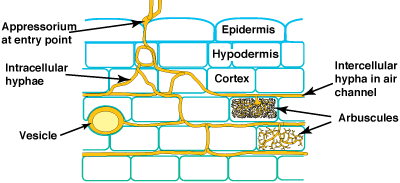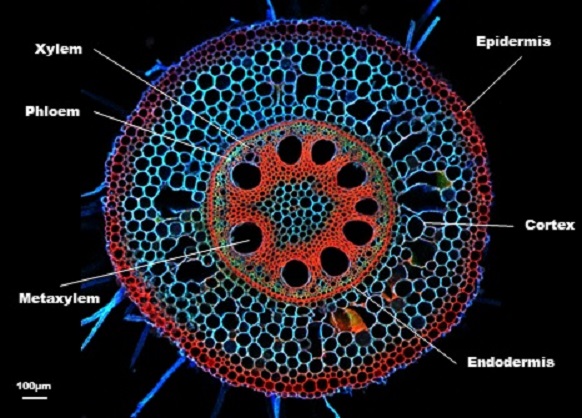Published August 31, 2020 | By Mike Petersen
Image 1:
Cross section (100X magnification) of a corn root
As I have been tasked to dig some deep holes in order to observe roots for purposes of what type, how deep and water availability profiles of some specific corn breeding types this summer, I got to thinking that a number of you reading may be interested in what the real important features of a root system. Let me write what a few of those are as we are now into the last days of the fruiting bodies doing their thing before dry-down. For those of you in the northern latitudes with it being latter days of summer we are seeing corn dent in places, soybeans filling the last pods up high in the plant architecture, dry edibles starting to turn yellow and beans in the pods firm, the nuts of the sunflowers and shells are hardening, and cotton is in later segment of boll filling.
First basic premise of roots – anchoring the plant above ground structures (stems, leaves, nodes, branches and fruiting bodies). This root system whether monocots (grassy plants) or dicots (broadleafs), roots hold the plant upright like feet of man.
More importantly is the next topic…. the specific cells of the maize root comes in specific sections of the younger root tip area to the older tissues nearer to the stem that moves materials up and into the leaves. As depicted in the image in black off to the right, the epidermis cells are like our skin to keep the cortex cells hydrated to hold water, sugars, proteins, hormones. and conductive tissues named xylem, phloem and Metaxylem inside. Many of the cortex cells (as what you can see in the diagram off to the right) hold water to maintain plant turgidity and cellular metabolites for the lateral roots and hair roots to grow. The metaxylem cells are the large tubes for water, sugars and other metabolites for upward flow. The phloem tissues return products from the leaves downward along with hormone messages. Near the phloem tubes are phloem packets in a corn plant where specific metabolites are held during all phases of photosynthesis and keep the so called “engine” running 24/7. The endodermis is exclusive to roots, and serves as a checkpoint or gateway for materials entering the root’s vascular system from outside the root such as from bacteria living and dying on the root epidermis. Entry of nutrients such as N, P, Zn and S via mycorrhizae come into the root by the way of specific structures called hyphae. Please take a look at the image of hyphae of VAM (vascular arbuscular mycorrhizae) below. I am just showing this for this time and will go into more detail about mycorrhizae at a later time.
As I wrote in the very beginning about root investigations I have done this summer… with a past seasoned agronomist who worked many years for Monsanto we looked at roots that had root expansion that grew deep as the plants were in height above ground. We did the volumetric measurements of the root-to-soil interactive zone and the root systems expanded up to 5800 cubic inches in the soil below each plant of the better root developed hybrids. What that gives a plant in medium textured soils (sil, sicl, scl, loams) about 5.8 gallons of water to hydrate and feed those individual plants. That is at tassle time all the way up through the reproductive stages and beyond milk stage of the kernels a tremendous resource to finish all the kernels on the cob. With irrigation a grower can produce heavy weight corn up to 63lbs per bushel. Yes that depends upon kernel size, however fed and watered by irrigation or the clouds, corn producers who grow today’s corn hybrids with larger root systems will do great when the combine pulls into the field.
What does that have to do with Strip Till and this website blog? Starting off the plant right with nutrition placed where the soil has been tilled in a specific zone goes a long way in setting the potential for big corn yields. Selection of a great rooting hybrid, nutrients right in the pathway of the root growth, residue to cool and blanket the soil for a portion of the growing period, residues to provide the carbon sources for the microbes, worms and other invertebrates who live in the soil – all working in harmony with a strip till system makes tons of sense and provides the environment for a corn plant to thrive. It means the world to us at Orthman how we are providing said environment with strip tillage via the 1tRIPr. You have more questions please get in touch with me or any of our guys as Territory Managers around the country. Their contact information is on this website and any of us would enjoy a conversation either by phone or email.
Harvest is around the corner and we look forward to it. May September be calmer, less wind, please some rain for those of us who live out west and no Hail! More to come folks as we look forward.

